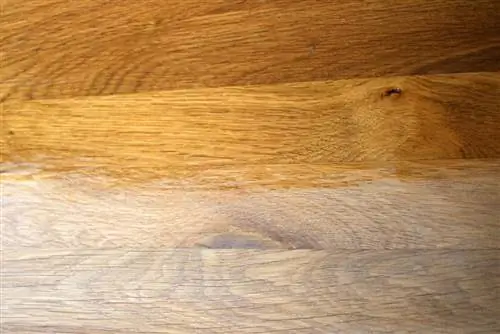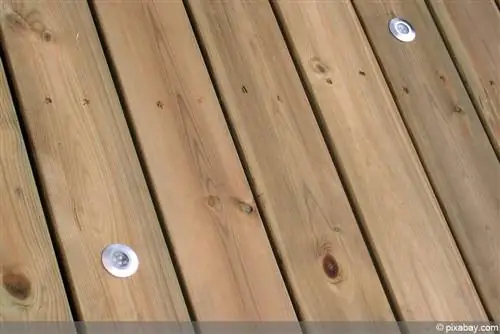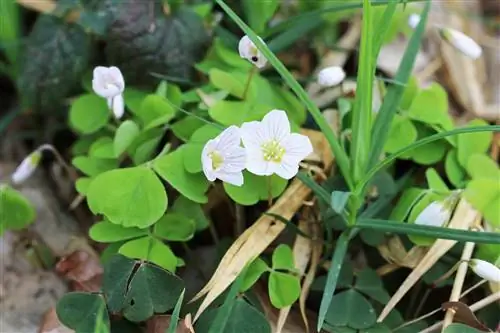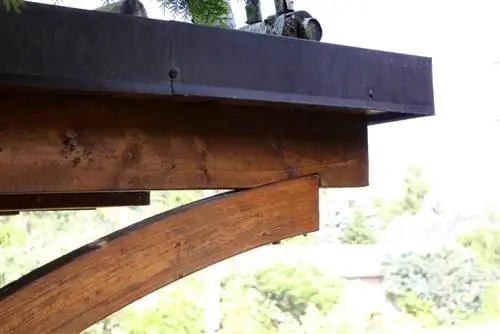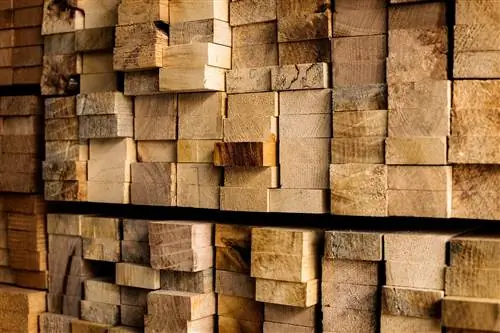- Author admin [email protected].
- Public 2023-12-17 03:39.
- Last modified 2025-06-01 06:48.
Wood protection gel is offered as a new form of classic wood preservative and is said to be easier to use compared to them. The products place a particular focus on application with brushes, regardless of what type of wood it is. They are specifically produced to be easily used by humans. But what about the ingredients and the effect?
Properties of wood protection gel
Products that are sold under the name wood protection gel are primarily aimed at private users in the home and garden who are looking for a reliable wood preservative that does not require much effort to apply. Since it combines the properties of wood stains and protective paints, according to the manufacturers, more and more people are interested in the gels. The following properties are achieved by the products:
- UV protection
- weatherproof
- fade resistant
- effective against fungal and mold infestation
- doesn't drip
- don’t spray
- no noses are formed during application
- dilutes during use; This makes application easier
- Due to the gel consistency, color pigments are not concentrated or deposited in one place
- Gel does not need to be touched or stirred during breaks
- some products can even be used indoors
Due to these properties, wood protection can be a good alternative to quickly and effectively treat all types of wood outdoors. The biggest advantage is the quality of the gel. The treated exterior surfaces are more durable and, depending on the product, need to be refreshed every seven to ten years. They are offered as a type of all-in-one solution with long-term protection that is intended to replace the following glazes:
- Thin-layer glaze
- Middle layer glaze
- Thick-layer glaze
- Wood protection paint
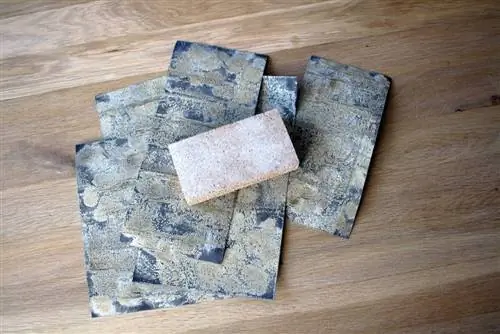
The fact that the gels can theoretically be used to treat all wooden surfaces and components in the garden is due to the consistency mentioned above. This is so viscous that it does not run off surfaces and does not require stirring. It does not harden or form a layer in the can, which is beneficial for a variety of applications. This is why wood protection gels are so popular and are the easier option to use compared to other wood protection products in terms of application and properties. They are also available in a variety of colors to give the wood a fresh look.
Please note:
Despite the positive properties of the gel, not all users are really satisfied with the products. Many people complain about the poor coverage of the color pigments or the color itself, which develops completely differently after application than stated on the packaging.
Acquisition costs
Another aspect why wood protection gel can be a good alternative to glaze is its low price. In comparison, the gel is a fifth cheaper than high-quality glazes and is still an effective wood protector. The average prices at a glance:
- 1 l: 3, 5 - 6 euros
- 5 l (typical container size): 18 - 29 euros
Wood stain from manufacturers like Bondex, on the other hand, costs between 9 and 12 euros per liter, which brings the price for five liters to 45 to 60 euros. The actual cost of the gel is determined by the quantity, which in turn depends on the area. On average, 100 ml of gel is required per square meter for one coat. This means that one can is enough for 50 m² in one coat. But since the gel doesn't really work effectively with a single coat, at least a second coat has to be done, which halves the value. Depending on the frequency of coats - a third coat is often necessary in particularly harsh weather conditions - the amount required per square meter of area naturally increases.
Preparation
Processing a wood protection gel is much easier compared to glazes or oils, mainly due to its consistency. However, before you can use the gel, you must first make some preparations to prepare the wood for the treatment:
1. Cleaning: The surfaces must be cleaned beforehand so that the gel can develop its full effect. The following points in particular should be taken into account:
- free from dust
- free from dirt
- free from oils and fats
The wood must also be dry. This means that after cleansing you have to wait a while before you can apply the gel. It is also important not to treat the wood immediately after a shower, otherwise the gel will not be absorbed.
2. Resin residue: Resin should also be used before brushing. To do this, you should use a universal thinner that can be used to remove the resin according to the manufacturer's instructions, leaving treatable wood behind.
3. Old paints: For old paints, the preparation is a bit complicated and the old paint must be checked beforehand. If there are loose coats of paint, they must be completely removed beforehand so that the new coat of wood protection gel can be applied. If the entire coat of paint needs to be replaced, it must be sanded down. Depending on the area, this takes a long time, but the gel then absorbs deeply into the wood and ensures an optimal result. If the paint is extremely weathered, it must be sanded down to the wood, which is still he althy.
4. Pressure-impregnated or raw wood: If this type of wood is used, it must first be primed. Make sure to apply either one or two coats of primer. As soon as the foundation appears opaque, it is the right amount.
Processing
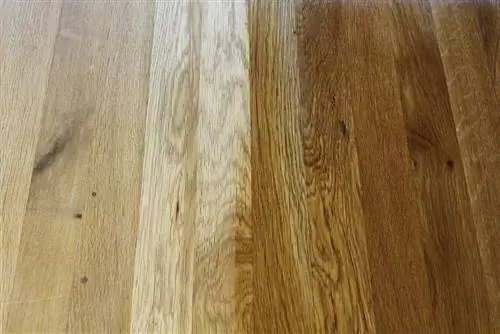
The processing of the gel is extremely easy thanks to this preparation. The better the wood is pretreated, the more opaque the end result will be. When processing, proceed as follows:
1. Use a paint brush that can be easily dipped into the container.
2. As mentioned above, you don't need to stir the gel. It has been designed so that you just have to dip the brush to carry out the treatment on the wood. A big advantage is that you don't have to hurry because the gel doesn't dry.
3. When painting, you really just have to make sure you apply enough layers. You can use the following rules of thumb as a guide:
- normal side: twice
- Weather side: three times
- Oak wood: three times
Of course, you should always use your eyes a little and if two coats don't seem to be enough, a third coat is a good idea.
4. The gel should always be applied in the direction of the natural grain of the wood. This makes it easy to apply the wood preservative.
Environmental sustainability
Despite its effectiveness and problem-free treatment, which makes it the ideal wood preservative, like many other glazes or products it is not really environmentally friendly. This is due to the ingredients, mostly solvents, which can affect humans and animals. These include:
- Cob alt carboxylate
- Butanone oxime
- Alkyd resin
- White spirit
- artificial pigments
- Additives
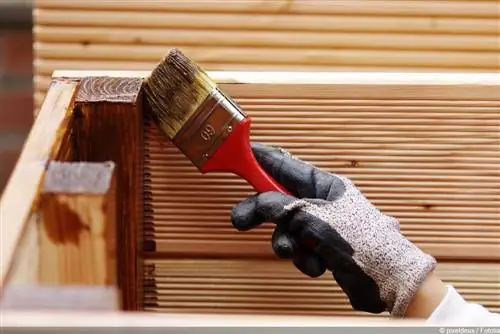
Even small amounts of these can cause allergic reactions or unpleasant sensations such as headaches or nausea. This is due to the vapors that escape from the product during use and can be inhaled by you. Since the gels are mostly used outdoors, this effect is not as intense as it would be indoors. Furthermore, the gels have a harmful effect on bodies of water and their aquatic organisms, especially those that contain cob alt carboxylate and butanone oxime. For this reason, empty containers must be handed in to waste collection points. Wood protection gels are only environmentally friendly if they have the following quality mark:
RAL-GZ 830
This belongs to the Quality Association for Wood Preservatives e. V. and is only awarded to wood preservatives that are harmless to he alth and environmentally friendly with the same performance. In general, when using wood protection gels, you should pay attention to the safety instructions on the packaging so that you can use them without any problems without harming your he alth or nature. Otherwise, all wooden surfaces can be efficiently treated with wood protection without having to use a classic glaze.

